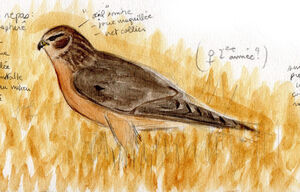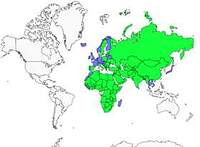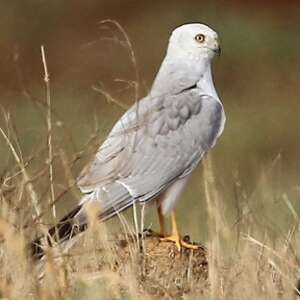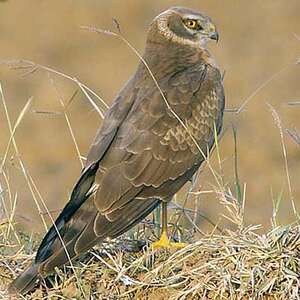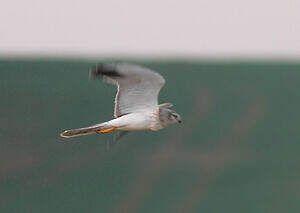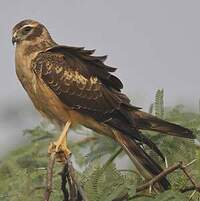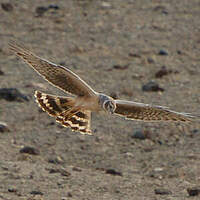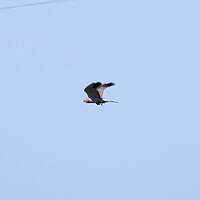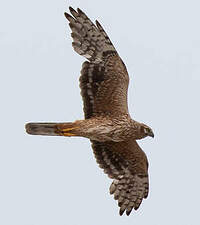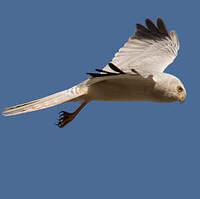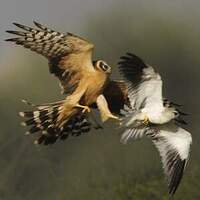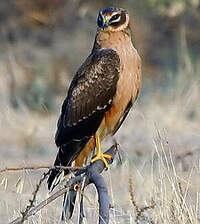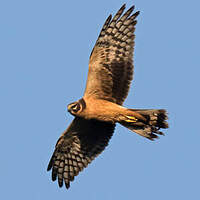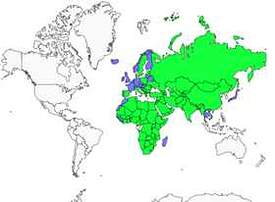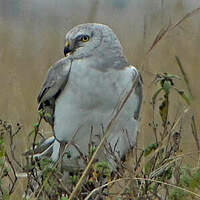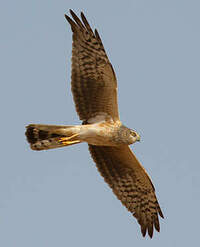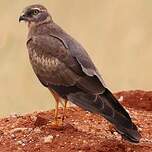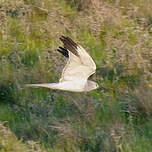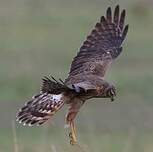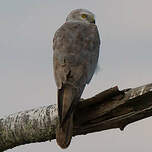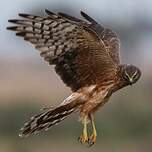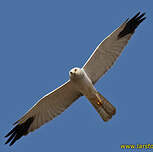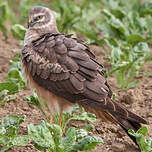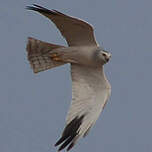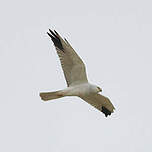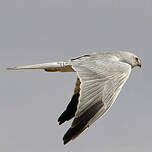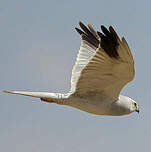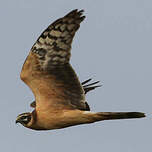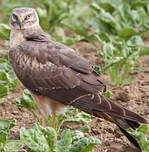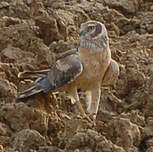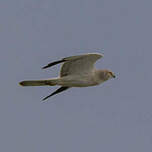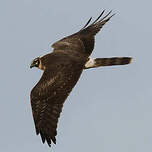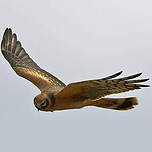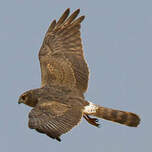Pallid Harrier
Circus macrourus - Busard pâle
Identification
The identification of the Pallid Harrier presents difficulties due to the closeness with the Common Harrier in certain plumages. We will emphasize the distinctive characters. As with all harriers, sexual dimorphism is very great.
The adult male is easily recognizable by its typical grey ash above, white below with the head very pale and the tip of the wing black.
The iris is yellow lemon to golden yellow. In flight, it is even easier to identify. It is completely clear, except for the black tip of the wing. No dark bars in the wing. Furthermore, the black only concerns primary remiges 6 to 9, the seventh being the longest black, giving the impression of an inserted black brush or corner at the tip of the wing in a downward view. The photos show this well.
The adult female resembles the Common Harrier female, brown above with a white patch at the rump and a pale area on the coverts, russet / whitish below with the chest streaked and the wings marked with brown. Compared to the female cendré (between parentheses):
- the silhouette is finer and the flight more dynamic,
- the pale areas framing the eye are reduced to 2 quite thin traits, one above and one below (pale eye zones much wider),
- the cheek is largely dark brown and limited at the back by a more marked pale arch forming a collar (cheek less brown and no pale arch),
- the axillaries are brown and dotted with whitish (clearly barred with brown),
- from the bottom, pale primaries irregularly barred, pale internals at the extremity (regularly barred and ended with dark),
- finally, the secondary remiges are darker than pale, in contrast with the back (as dark as pale, with less contrast).
The birds become reproductive adults at 3 years old, but the male does not show its perfect adult plumage until the age of 4.Immature plumages are complex and in their second year the sexes are similar except for the eye, which is already yellow in the male.
The juvenile is very similar to the adult Cinereous Harrier, dark brown above with the white rump, plain orange-buff below. To distinguish them it is necessary to use the same criteria as for an adult female. Two in particular can be observed in the field if a juvenile is in flight: the Pallid Harrier has a distinctive pale collar at the back of the cheeks, and its very dark secondaries are in stark contrast to the wingtips.
Subspecific information monotypic species
Foreign names
- Busard pâle,
- Aguilucho papialbo,
- tartaranhão-pálido,
- Steppenweihe,
- fakó rétihéja,
- Steppekiekendief,
- Albanella pallida,
- stäpphök,
- Steppehauk,
- kaňa stepná,
- moták stepní,
- Steppehøg,
- arosuohaukka,
- Witborspaddavreter (Witborsvleivalk),
- arpella pàl·lida russa,
- Fölheiðir,
- błotniak stepowy,
- stepes līja,
- stepski lunj,
- Степной лунь,
- ウスハイイロチュウヒ,
- 草原鹞,
- เหยี่ยวทุ่งสีจาง,
- 草原鷂,
Voice song and call
The Pallid Harrier, like other harriers, is rather silent outside of the breeding season. On the territory, alarm calls such as tserek trek trek are heard, reminding a bit of the call of the Redwing. Other rolled cries triririririri can be heard as well as sharp and chattering series of notes kri kih kih kih kih. The voice has a lot of similarities with that of other harriers.
Habitat
The Pallid Harrier breeds in semi-deserts, steppes and steppe woodlands up to 2000 metres altitude. Its preferred sites are wet meadows close to water and marshes.
In winter, savannah replaces the steppe. It also frequents savannah woodlands, semi-deserts and wetlands for their abundance of birds.
Behaviour character trait
The species is migratory. The majority of the birds winter well in the south, in Sub-Saharan Africa or India.
They leave their breeding area from August to November and return northwards in March and April. They migrate across a wide pathway and are capable of crossing the Mediterranean at its widest point, usually in solitude, but females and juveniles can form groups of 10 to 15 individuals. Minor concentrations can be observed at the straits. The birds in migration fly on average higher than when hunting, up to a 15th of a meter.Flight
The flight of the Pallid Harrier is more vigorous and resolute than that of the Cinereous. It's silhouette is more sleek. It is able to reach high speeds when it is hunting birds for example. Its flying capabilities allow it to make long over-flights of the Mediterranean during times of migration.
Dietfeeding habits
The Pallid Harrier spends much of the day hunting, flying distances counted in kilometers, up to 20th, it is thought.
Like other harriers, it flies close to the ground, from 1 to 9 m, head turned towards the ground and diving onto its spotted prey.It mainly feeds on small rodents, up to the size of a vole, including, hamsters, lemmings, etc. It is very dependent on them, and their abundance determines the reproductive success. Its flying abilities allow it to attack birds, which the Cinereous Harrier does not do. During the summer season, it mainly captures young passerines. pipits, larks, etc. Occasionally, it captures lizards and insects.
Reproduction nesting
The Pallid Harrier is monogamous and territorial. It becomes reproductive at the age of 3. The adults return to their sites in March-April.
This is followed by a period of setting-up, courtship and nesting. Laying takes place in May-June. The pairs nest in isolation or in loose colonies of 3-5 pairs, sometimes more until 30, occasionally in sympatry with the Montagu's Harrier. This can lead to occasional mixed couples and hybrid young. The site can change from one year to the next, mostly due to fluctuations in the vole population. The nest is made of grass piled up to the ground and protected by the surrounding vegetation. The female lays 4-5 eggs (3-6) and incubates them for 29-30 days per egg. The male feeds her during this period. The young stay in the nest for 5-6 weeks and the parents continue to take care of them for another 2 or 3 weeks. They will become sexually mature at the age of 3, sometimes as young as 2. Their life expectancy is 10-15 years.Geographic range
The Pallid Harrier mainly breeds in the grassy steppes of Asian Russia, Kazakhstan, and northwestern China. Small populations breed in Europe (Azerbaijan, Romania), in Asia Minor and Ukraine.
It is a long-distance migrant, wintering mainly in sub-Saharan Africa (especially in the central parts of the continent) and in the Indian subcontinent. A minority winter in the southern edge of the breeding range in Turkey, the Balkans, Iran, and south of the Caspian Sea. It migrates over a wide front and is not dependent on the raptor migration routes such as the Bosporus or Gibraltar. A certain number of birds need to fly west before turning south. It is observed in all the countries bordering the Baltic Sea, the North Sea and the Atlantic, from Finland to the north. In France, it is said to be more frequent now, but perhaps it is simply better recognised.
Threats - protection
IUCN conservation status
concern
in the Wild
threatened
evaluated
The species has been classified as nearly threatened. There has been a decline since the last century, which appears to be continuing at a rate which is difficult to measure due to the inconstant nature of the species.
The breeding population is estimated to be between 9,000 and 15,000 pairs. Observations in the north and west of Europe have increased in recent years, with regular reproduction in Finland and wintering data in several other countries. From this, two opposite conclusions can be drawn. The Pallid Harrier is more frequent in the West of its range either because its situation is improving in Asia, or the reverse, a deteriorating situation. There is a lack of reliable data to understand the real trend. But the species is not easy to follow, on the one hand because it is rare, and on the other due to the fluctuations in environmental conditions which determine the abundance of small rodents, its preferred prey. Inter-annual fluctuations are strong.
In its breeding range, the species is mainly threatened by destruction and degradation of its natural habitat, the steppe, due to the conversion to crop fields, intensive pasturing of wet meadows, burning, various clearings, etc. In its wintering range, burning and overgrazing are certainly having a negative role. All of this deserves to be studied in more depth.
Sources of information
- IOC World Bird List (v14.2), Gill, F and D Donsker (Eds). 2024-04-18.
- Birds of Africa South of the Sahara, Ian Sinclair and Peter Ryan
- Birds of Prey of Africa and its Islands, Alan and Meg Kemp
- Guide des rapaces diurnes : Europe, Afrique du Nord et Moyen-Orient, Benny Gensbol
- Vol. 2 - Handbook of the Birds of the World, Josep del Hoyo-Andrew Elliot--Jordi Sargatal
- The Raptors of Europe and The Middle East, Forsman Dick
- ARKive, Christopher Parsons
- BirdLife International, BirdLife International
- Birds of the World, The Cornell Lab of Ornithology
- Wikipédia, Wikipedia, The Free Encyclopedia
- xeno-canto, Sharing bird sounds from around the world,
Other sources of interest
 Specification sheet created on
26/07/2023 by Jean François
Specification sheet created on
26/07/2023 by Jean FrançoisTranslation by AI Oiseaux.net
© 1996-2025 Oiseaux.net
- Accipitriformes
- Aegotheliformes
- Anseriformes
- Apodiformes
- Apterygiformes
- Bucerotiformes
- Caprimulgiformes
- Cariamiformes
- Casuariiformes
- Charadriiformes
- Ciconiiformes
- Coliiformes
- Columbiformes
- Coraciiformes
- Cuculiformes
- Eurypygiformes
- Falconiformes
- Galliformes
- Gaviiformes
- Gruiformes
- Leptosomiformes
- Mesitornithiformes
- Musophagiformes
- Nyctibiiformes
- Opisthocomiformes
- Otidiformes
- Passeriformes
- Pelecaniformes
- Phaethontiformes
- Phoenicopteriformes
- Piciformes
- Podargiformes
- Podicipediformes
- Procellariiformes
- Psittaciformes
- Pterocliformes
- Rheiformes
- Sphenisciformes
- Steatornithiformes
- Strigiformes
- Struthioniformes
- Suliformes
- Tinamiformes
- Trogoniformes

